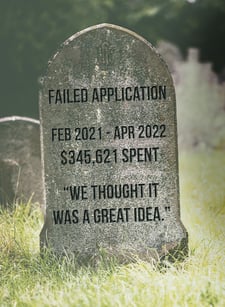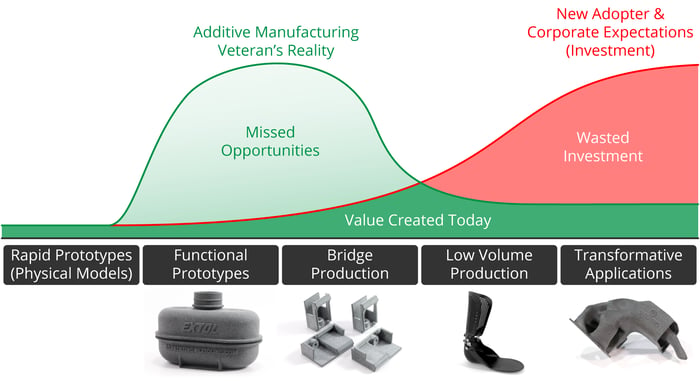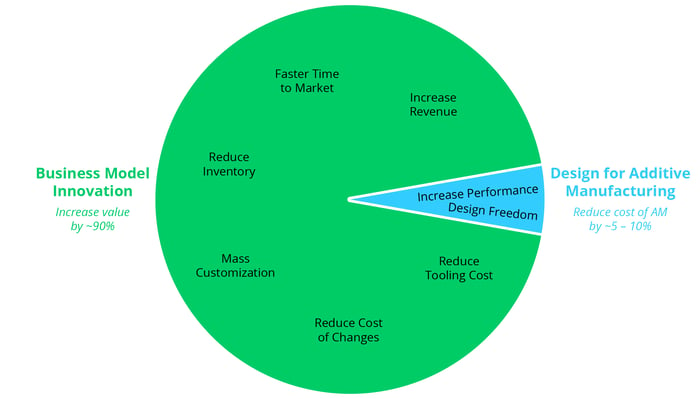Which Unlocks More 3D Printing Applications? - DfAM or Business Model Innovation
Despite the promise of Additive Manufacturing (AM), many organizations have failed to capitalize on its potential. This is partly because AM presents a unique set of challenges, which can be difficult to overcome without extensive experience and expertise. As a result, many organizations have pursued applications that are not well-suited for AM, leading to late and expensive failures.
In order to maximize the benefits of AM, organizations need to invest in and deliver successful applications. With the right approach, AM has the potential to change the world.
Which Additive Manufacturing Applications are Successful?
Develop functional prototypes and bridge production applications first
In the additive manufacturing industry, there is a lot of anticipation surrounding the transformative potential of the technology. New adopters and corporate entities expect additive manufacturing to provide significant production applications, resulting in operational efficiencies and enhanced design capabilities.
 While additive manufacturing has been hailed as a transformative technology with the potential to revolutionize production, in reality, the transformative and production applications have not been as successful. They have the highest requirements in terms of materials, design, and process control, as well as the most challenges in competing with the production cost of traditional manufacturing.
While additive manufacturing has been hailed as a transformative technology with the potential to revolutionize production, in reality, the transformative and production applications have not been as successful. They have the highest requirements in terms of materials, design, and process control, as well as the most challenges in competing with the production cost of traditional manufacturing.
Consequently, these applications have seen only limited adoption, resulting in many late and expensive project failures. But what if we didn't waste investment on these failed applications? Instead, what if we took the time and money that many are investing in these low-yield applications and redirected it into developing functional prototypes and bridge production?
Speed is king in functional prototyping and bridge production
After working in the field for many years, one realizes that the most successful applications in additive manufacturing are in functional prototyping and bridge production. Speed is king for both of these application categories, and AM shines.
In functional prototyping, AM provides a means to quickly and economically produce prototypes with similar function and robustness as the final product. This is especially important for products that undergo testing, as it allows engineers to iterate on designs more quickly.
Bridge production is another critical area where AM can be used to rapidly produce parts when traditional manufacturing methods are unavailable or too expensive. For example, suppose a small batch of parts is needed for customer beta testing or field trials. In that case, AM can produce these parts without incurring the high costs and lead time associated with tooling for traditional manufacturing methods.
After building on successes with easier applications that return value quickly to the organization, the organization can use the momentum and experience to pursue transformational production applications.
Why are so many organizations investing in the wrong applications, and how do we fix it?
Design for Additive Manufacturing (DfAM) and Business Model Innovation are two tools to create value with AM. DfAM is changing the design to create value with AM. Business Model Innovation is changing how you do business to create value with AM.
 Design for Additive Manufacturing (DfAM) is important, but it only scratches the surface of what's possible with additive manufacturing. DfAM focuses on taking advantage of AM's capabilities to create parts and products. This is important, but there is a greater opportunity to be found in Business Model Innovation.
Design for Additive Manufacturing (DfAM) is important, but it only scratches the surface of what's possible with additive manufacturing. DfAM focuses on taking advantage of AM's capabilities to create parts and products. This is important, but there is a greater opportunity to be found in Business Model Innovation.
Business Model Innovation (BMI) with AM can dramatically increase efficiency and effectiveness in a wide range of industries. It has the potential to create new value propositions, reduce costs, and enable entirely new business models. Business Model Innovation is a hidden opportunity that gets less attention because it's harder to see and quantify. The benefits of Business Model Innovation often accrue over the long term, making it harder to measure the impact in the short term. The rewards are worth the effort, making Business Model Innovation the more significant opportunity worthy of attention.
Innovation is more than just invention.
One reason AM is not creating as much value as expected is that we are missing the fundamentals of innovation. First, there is a difference between innovation and invention. Invention is creating something new, while innovation is creating something new that has value to someone. An invention becomes an innovation when users vote on the value with their wallet.
While much invention is happening, not all of it is innovation. DfAM can be innovation, but it is not by itself. For AM to create more value, we need to focus on creating innovations that people will want to use. Otherwise, we will continue to fail to deliver value that justifies AM.
How to do Business Model Innovation
Business Model Innovation is critical, but it requires digging below the surface. How do you do it time after time to find the most successful applications?
Key 1 - Ask what AM can do for your business, not what you can make with AM.
AM is an expensive technology. To launch successful applications with AM, companies must do more than try to compete head-to-head with traditional manufacturing on part cost. DfAM is rarely enough to reduce the cost of AM to be competitive head-to-head with conventional processes. We need to find other angles of attack to create value in exchange for the increased part cost of 3D printing.
There are many known benefits to using additive manufacturing, such as faster time to market, mass customization, eliminating tooling costs, and design freedom. Most of these benefits come not from the technology itself but from Business Model Innovation. In other words, companies that are successful with additive manufacturing are those that have found new ways to use the technology to create value for their customers. This could involve anything from customizing products on-demand to reducing lead times for development.
While some benefits of additive manufacturing, like design freedom, do come from the technology itself, it is clear that most of the value lies in using AM to change the way you do business.

Key 2 - Involve a cross-functional team.
A consistent and repeatable path to innovation is through Human Centered Design (HCD).
HCD tells us that innovation requires all 3 aspects to be successful:
- User Desirability - the user must want the product enough to give up something for it.
- Business Viability - the product must be able to be produced and sold at a profit for a sustainable business.
- Technical Feasibility - the product must be able to be created.
 AM technology is constantly evolving, and engineers are often at the forefront of these developments. We are great at invention and spend most of our time on technical feasibility. We focus on what we CAN make (technical feasibility), not what we SHOULD make (user desirability and business viability). Involving a cross-functional team can help us see the bigger business impact.
AM technology is constantly evolving, and engineers are often at the forefront of these developments. We are great at invention and spend most of our time on technical feasibility. We focus on what we CAN make (technical feasibility), not what we SHOULD make (user desirability and business viability). Involving a cross-functional team can help us see the bigger business impact.
By working with other teams, we can better understand the user’s needs and pain points. This allows us to develop solutions that are not only technically feasible but also user-friendly and commercially viable. In addition, involving other teams can help to prevent scope creep and ensure that the project stays on track from a business perspective. Ultimately, a cross-functional team approach is essential for successful AM projects.
Key 3 - Follow a proven innovation process.
The next piece of the puzzle is following a proven innovation process. Business Model Innovation is often hidden under the surface and not obvious. Digging under the surface becomes easier when relying on a proven process.
At Extol, we use a Digital Development Program™, which is based on the proven innovation processes of Human Centered Design and Design Thinking. This helps us uncover opportunities, develop feasible solutions from a technical and business standpoint, and ensure that we are developing a winning solution. Or in some cases, we learn very early that there is no path to success, so we kill the project before wasting time and money developing it. Failing fast on applications that will not bear fruit is critical so you can move on to other applications.
By following this process, we help our customers find the applications where AM creates the most value for their business. Our Digital Development Program uses four steps. Steps 1-2 identify the problem to be solved. Steps 3-4 create a solution.
- DISCOVER opportunities. Understand the context of the application, the stakeholders, the customer journey, and pain points.
- DEFINE the value and requirements - identify the problem you will try to solve by naming the requirements like appearance, strength, lead time, and cost. Most importantly, define what will make AM a win compared to alternatives.
- DEVELOP the additive design and validate. Develop the solutions to meet the requirements. Complete testing to validate that the solutions meet the requirements.
- DELIVER scalable manufacturing. Implement a repeatable production process that will meet the requirements over and over again at scale.

Let us help you find and develop the best applications for AM
Additive manufacturing is a process that has vast potential for businesses looking to innovate and create value for their customers. While DfAM is important, Business Model Innovation is critical to unlocking more applications. To be successful with Business Model Innovation:
- Ask what AM can do for your business, not what you can make with AM.
- Involve a cross-functional team
- Follow a proven innovation process
At Extol, we specialize in helping our clients uncover these opportunities and develop feasible solutions from a technical and business standpoint. Let us help you find the 3D printing applications where AM creates the most value for your business! Use the contact form below to get in touch and discuss your application!

